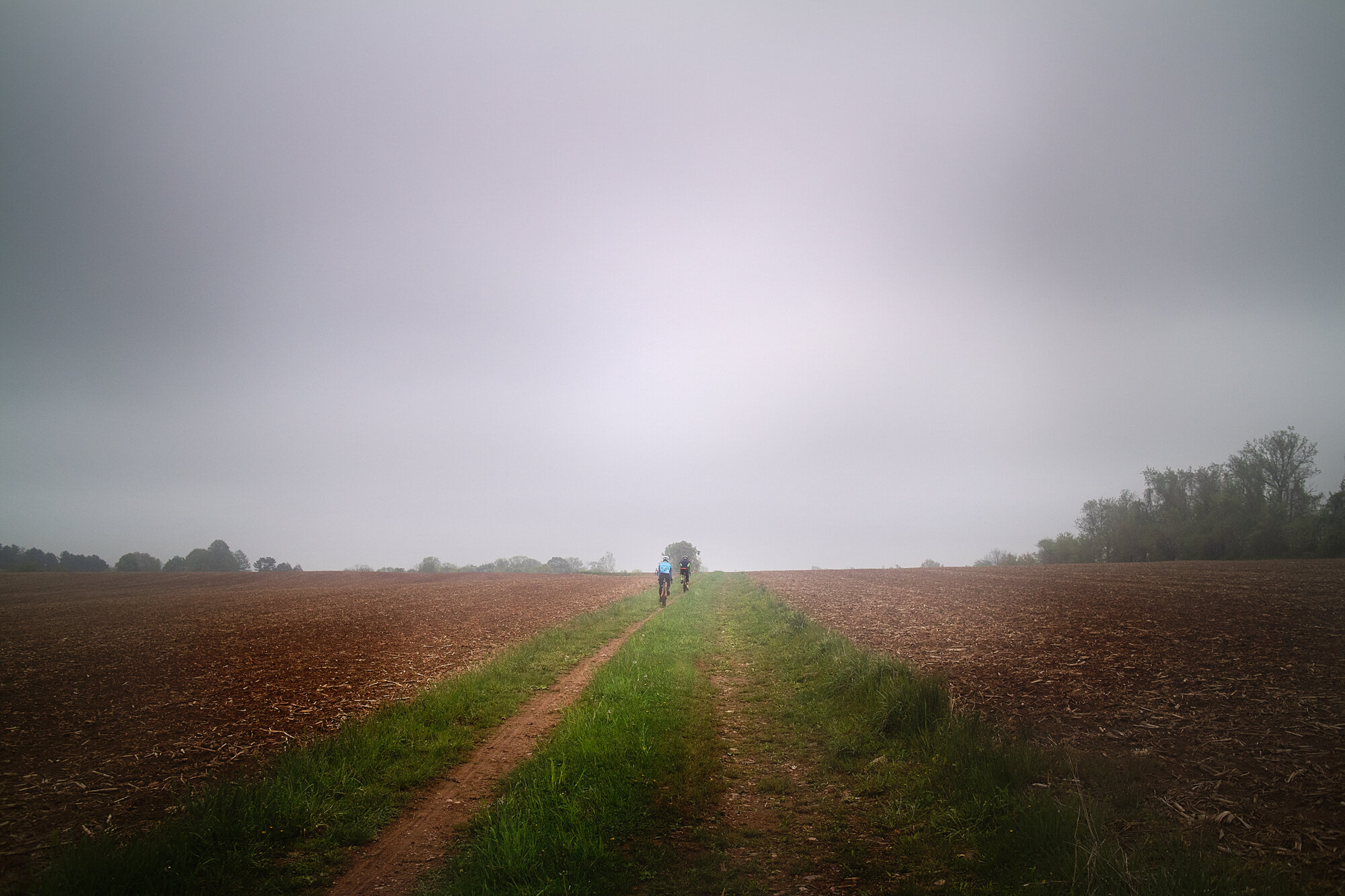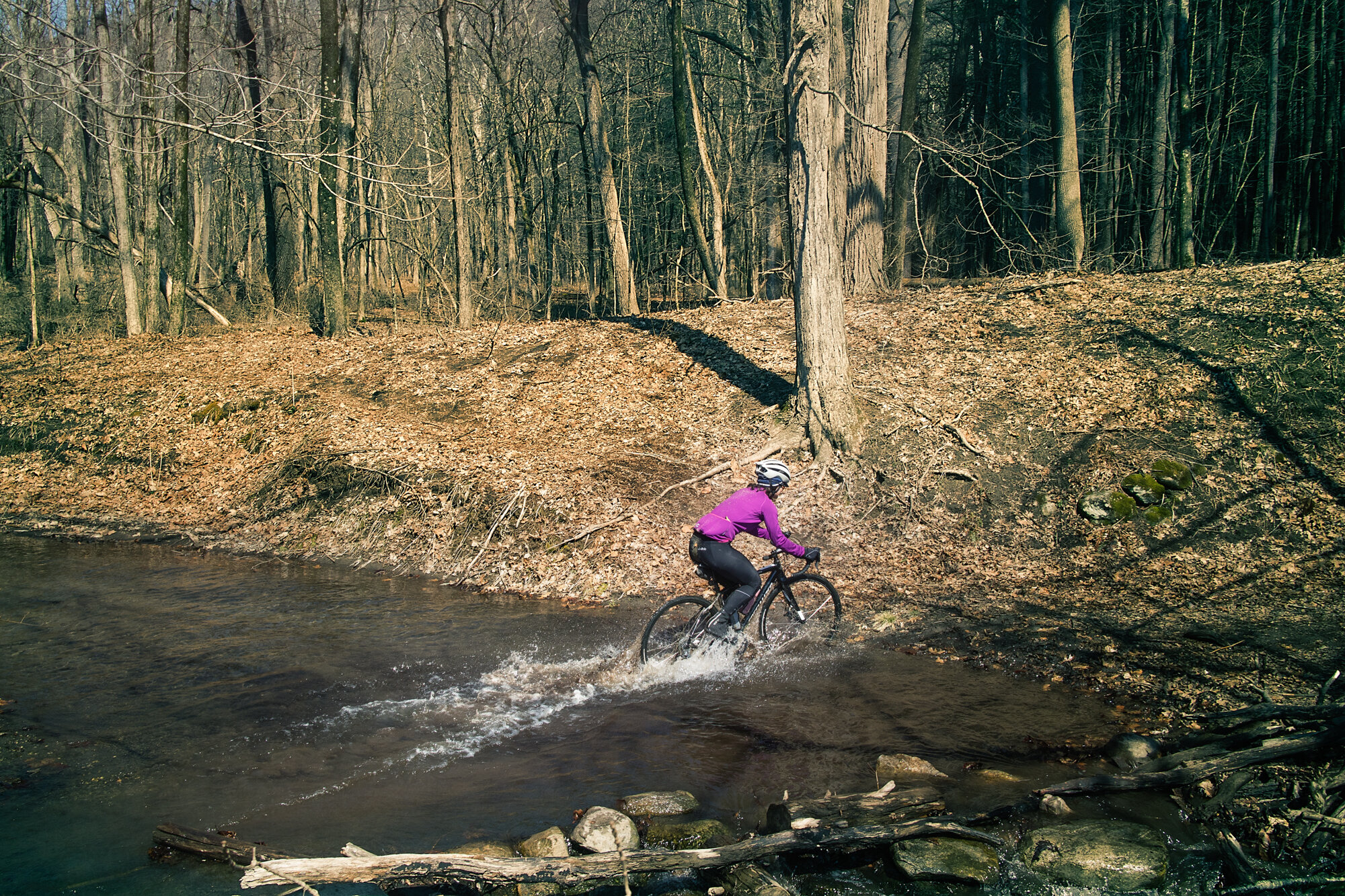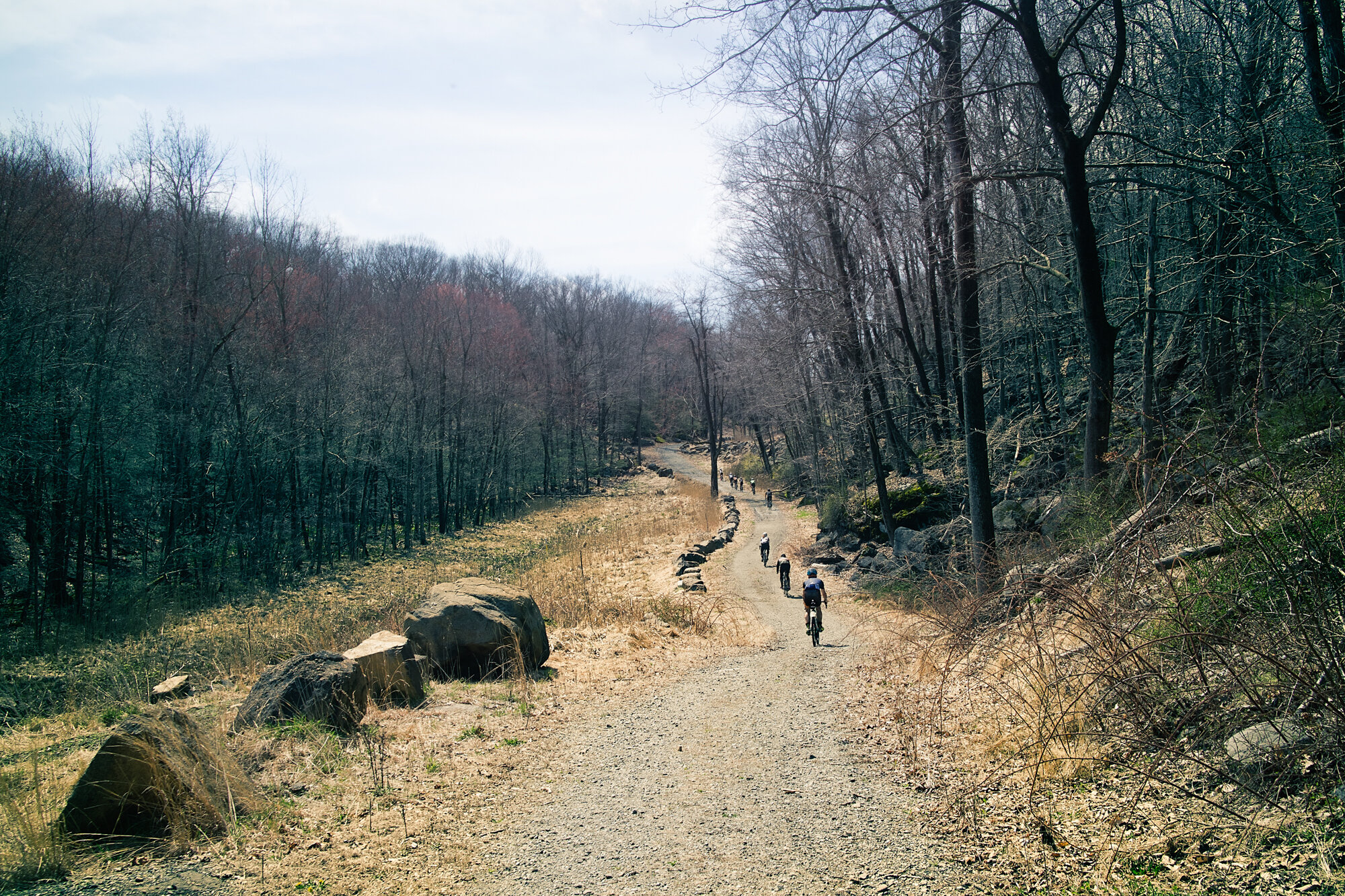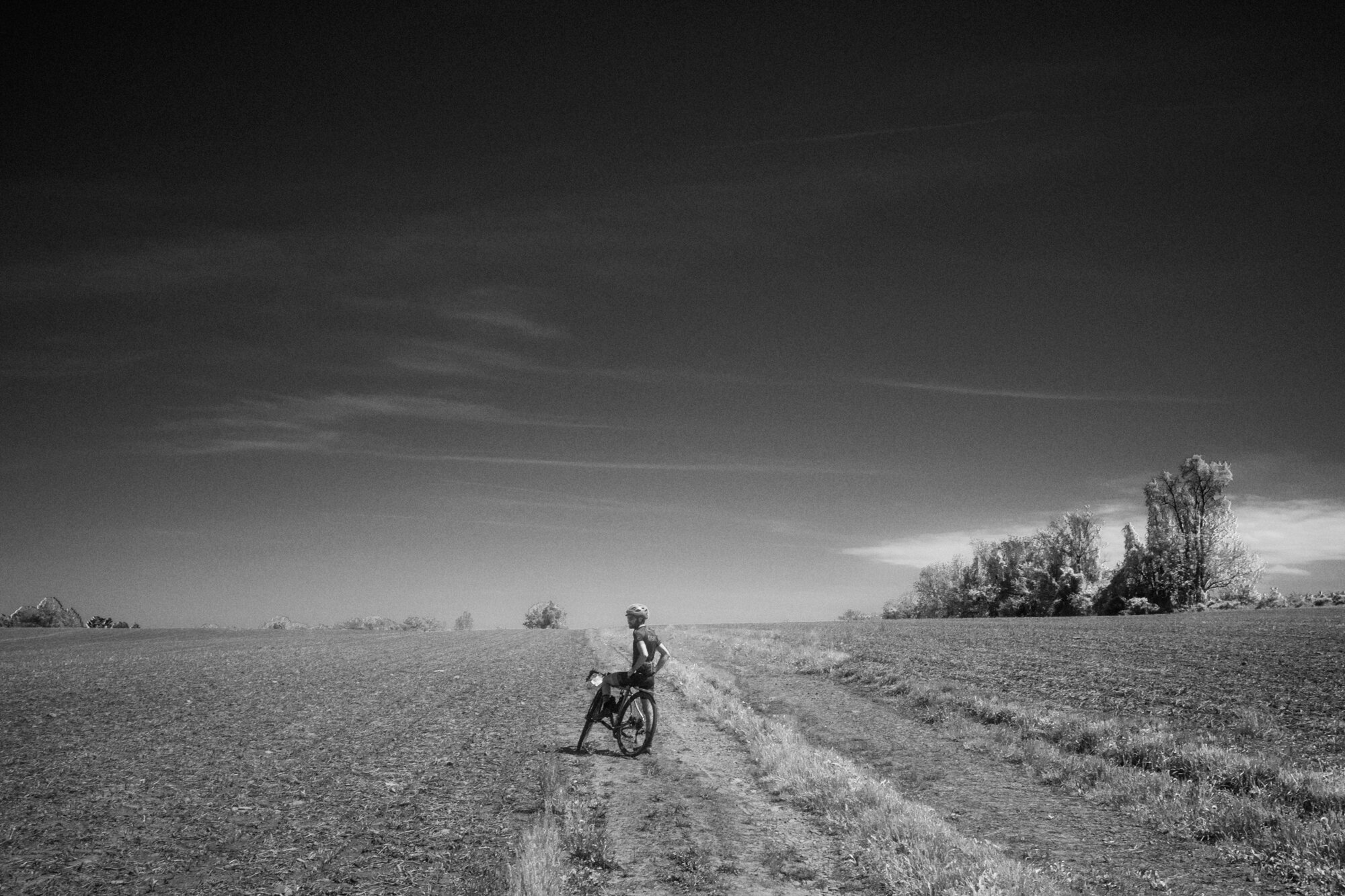Converting Roadies into Dirt Lovers: The D-SIG Interview
Words: Lucia D, Brian Sullivan, John Siemens
Photographs: Jon Shireman
New York Cycle Club is home to the recreational cyclist, as CRCA is home to the amateur bike racer in NYC. The NYCC has over 2000 members and in addition to a calendar of daily member led group rides, NYCC is most well known for its completely volunteer-run, zero-cost SIG program. The “SIG” is a technique immersive training series that teaches safe group riding skills to riders at all levels. Several members of TBD are NYCC SIG graduates, including myself. Following the popularity of off-road riding, a couple of innovative SIG leaders decided to create the D-SIG, which as you probably guessed, focuses on dirt riding skills. We chatted with Brian Sullivan and John Siemens, the masterminds behind NYCC’s newest and very popular “Dirt” SIG to learn more about the program, how their idea came to be, and why they think it’s earned such a following.
“The D-SIG is built around a progressive series of 10 rides, each longer and more demanding than the last. Every week the leaders will introduce and offer instruction around specific learning points, ranging from bike handling technique to group dynamics and problem solving. The program's leaders are veterans of the A-SIG and A-Classic and accomplished dirt riders, dedicated to building the skills and confidence of their participants through coaching and mentorship. The A-SIG and A-Classic programs provide an excellent introduction to dirt riding; the D-SIG will help you become a great wheel on dirt.”
~ NYCC D-SIG Program Description
I met both of you through the NYCC when I was a participant in the A-Classic SIG. Tell me a bit about your background. How did you get involved in cycling and the NYCC?
Brian: I rode obsessively when I was a kid. My first bike was a yellow coaster-brake job with a banana seat. It got me around but by the time I learned about “cool”, I was aware it was not cool. In 4th grade I saved my allowance money and talked my folks into going 50-50 on a sky blue Schwinn Scrambler bmx bike. That was a cool bike. I rode a ton in middle school and high school - built my own road bike from the frame up, and got as far as trying the Gimbels Ride a couple times (and got dropped)! My college years started a long hiatus from the sport: bike and gear ended up in a storage locker.
Fast forward to 2007. I moved from a small apartment to a bigger place and got my stuff out of storage: my beloved Reynolds 531 Trek frame, wheels I’d built myself when I was 17 with dry-rotted tubular tires, and sweet Diadora slotted-cleat shoes with leather formed to the shape of my feet 20 years prior. I took a long look at this pile of ancient gear and remembered how much I loved cycling. I connected with NYCC in 2008 and completed the A-Classic SIG* in 2009.
That fall I heard about Tour of the Battenkill - a cool new thing at the time. I joined CRCA to learn how to race, and through friends, met Robert Olsson, a racing legend who showed me the best nearby dirt roads: Old Albany Post, Indian Brook, and Sunken Mine. I got on the podium at Battenkill - my first out-of-town race - and my love of dirt was consummated.
Over the years, I raced and helped lead the A-Classic SIG, and continued exploring the networks of dirt roads Rob Olsson first showed me. Those became my obsession. I kept scouting, and when I thought I knew what I was doing, brought some of my fellow A-Classic leaders along. Those rides with that crew formed the basis of the D-SIG.
John: Growing up in Palo Alto, CA, cycling was part of the mainstream culture. We even had Bike Lanes in the early 1970s. I spent my formative years on a bike of some kind. Whether pretending to be a motocross racer on my String-Ray in a vacant lot, or riding my ‘ten speed’ in the Santa Cruz mountains, the bicycle was my source of freedom. Even my after school job was assembling bikes for a local bike shop.
My involvement with the New York Cycle Club started around ten years ago. I did the B, the A, and the A-Classic SIG programs as a participant. I served on the NYCC Board of Directors for two years. It was while I was an A-Classic SIG leader that I met Brian and his orbit of dirt/gravel riding aficionados. It is from this group the leadership team of the first edition of the D-SIG was formed.
Photo by Jon Shireman
You have been A-Classic SIG leaders for a long time, what led you to create a separate Dirt SIG?
Brian: It was really John’s idea to start the D-SIG. I loved the mix of riding I was doing five years ago: road racing with my team, CRCA/E2Value, helping lead the A-Classic in the spring, and taking my friends on weird & hard dirt rides whenever I could. Those dirt rides were challenging and rewarding in a way that most road rides weren’t - but to be safe, also required a new set of group riding skills that we developed by trial and error. Over time, more of our friends became interested in doing these rides, and we started thinking about how to formalize the group riding dynamics that made them safe.
John had the vision to take NYCC’s SIG template for riding pavement and adapt it to teach the additional skills that were keeping us safe riding as a group on dirt roads. He talked me into helping launch it. We recruited 10 more like-minded ride leaders and ran the first D-SIG the spring of 2018.
John: In 2017, I was recovering from an injury that kept me off the bike for the summer. By the time I was back on the bike in the fall, I was not able to ride with the group that had been riding all summer. I asked Brian to help me put together a series of 3 or 4 dirt routes that were progressively longer and harder, to get me back in the swing of things. I thought I would list these as NYCC club rides so I would have some company. The series was called Off the Beaten Pavement and I figured it would attract a handful of folks. The response was much better than I expected, so I recruited some of our A-Classic dirt riding leaders to help so we could accommodate more participants.
Participants of the OBP series gave enthusiastic feedback about these new routes and riding surfaces. Then one night over beers, Brian, Jon Shireman, Fred Harris and I were talking about how much fun we had leading these rides and how much the participants enjoyed the new routes. We started wondering if we could expand this series and create a dirt SIG. I half jokingly said we could call it the D-SIG since that was the next available letter in the NYCC SIG series and of course “D” would stand for Dirt (haha!) and not that we rode at a slower speed than the “C” SIG. The name stuck and here we are.
Was there resistance/reluctance by the NYCC to accept the concept of a D-SIG?
John: There was very little resistance from the Club to create a SIG for gravel/adventure riding. Then-president of NYCC, Christy Guzzetta, was looking for ways to expand what the Club was offering to its members. The only concern from the Board that came up was regarding the club’s insurance not covering mountain biking. Once we clarified the difference between what we were doing and mountain biking, we were good to go.
What are the prerequisite skills needed for a rider to participate in the D-SIG?
Brian: Our ideal candidates are “A” level riders who possess the group riding skills and empathy taught in the A-SIG and A-Classic. These skills can be learned from experiences outside of NYCC, so prior SIG experience is not mandatory, but advanced group skills and ability to ride with empathy are essential. We’d rather have a participant who might not be as strong, but is solid in the line, and will work to make the ride a better experience for their fellow riders, than someone who’s super strong but only riding for themselves & not for the group.
John: For the most part, the original group of participants on our dirt rides came from the A-Classic SIG leader team. There is a group riding skillset that is developed in the A and A-Classic SIGs that promotes trust and confidence to handle yourself safely in a group. Because of that skillset we were able to push ourselves further into uncharted territory knowing that we as individuals could take care of ourselves, and we as a group would look out for each other.
“We’d rather have a participant who might not be as strong, but is solid in the line, and will work to make the ride a better experience for their fellow riders, than someone who’s super strong but only riding for themselves & not for the group.”
How is the D-SIG curriculum different from the “standard” SIG programs?
Brian: On a high level we follow the format of the other SIGS, with the rides getting progressively longer and more challenging, and participants taking on more responsibility for the group each week. There is a specific set of group riding rules for dirt that we teach throughout the D-SIG. In the second half of the program, we start lacing trail sections into some of the rides, and give instruction on both individual technical trail skills, and group-oriented skills (knowing when to regroup on singletrack, etc). That kind of instruction is unique within NYCC and the SIGs.
John: It is a progressive program in three stages. The first stage is routes that could be listed as Club ride where anyone with the fitness and the Club-approved group riding skills can do. The second stage pushes the mental and physical endurance a la the A-Classic SIG, the routes are longer with more elevation and we go further out so bail out options are more limited. The third stage gets us into terrain and territory that the leaders like to ride. In this last stage, skills & endurance, both mental and physical, are challenged and we are even further from home so the best bail-out is finishing the ride.
What are the most challenging skills for D-SIG participants to master?
John: Everyone has different strengths and weaknesses whether it be trail riding, loose gravel, descending on rutted dirt roads, etc., but probably the most common challenge is to deconstruct the classic paceline formation that has been drilled into most of the NYCC club members from the other SIGs.
On the dirt we do ride as a group, but each rider is responsible for their own line and to be aware of the riders around them. So getting folks to create a new habit of spreading out, maintaining a good sightline of the road ahead and awareness of riders in front, to the side and behind, can take some doing. Of course then we ask everyone to get back into a tight single line group on the paved sections. The efficient transitions between these two riding philosophies is overall the biggest challenge.
“On the dirt we do ride as a group, but each rider is responsible for their own line and to be aware of the riders around them. So getting folks to create a new habit of spreading out, maintaining a good sightline of the road ahead and awareness of riders in front, to the side and behind, can take some doing.”
What is the best aspect of being a D-SIG leader?
Brian: To me the best part is seeing the improvement in skills and confidence among our graduates. Each year we had participants coming in who were experienced, accomplished road cyclists, but had some significant blockers when it came to riding on dirt. Seeing their transformation over the course of the program has been remarkable, and very rewarding.
The second best thing is the camaraderie and dedication of our D-SIG leaders: volunteers, one and all. It’s a very diverse group - people who have come to gravel riding all different ways - but all bring fantastic energy and enthusiasm to the program. Without them, there would be no D-SIG - or any SIG.
John: The best part of leading the D-SIG is sharing the new routes and the fun of adventure riding. I always love when someone has a moment of delight about a hilltop vista or riding along a river or stopping forest and they realize how good it is to take the time to soak it in.
One of the most memorable things a participant said on a ride was, “It’s so great to go on a bike ride and see animals that are still alive instead of just dead ones on the side of the road.” Maybe that is a bit graphic, but even veering slightly away from civilization gives us an opportunity to enjoy nature.
Photograph by Jon Shireman
How much gear talk is involved amongst the D-SIG participants and what would be the ideal gear (bike, tires, disc vs canti brakes, etc.) for the D-SIG?
Brian: Our stated requirement is a bike with drop handlebars, and tires 32c or bigger. We strongly recommend participants have a lowest gear close to 1-to-1, and SPD or similar pedals. Beyond that, we encourage “run what you brung”. We’ve had people finish the program on everything from touring bikes with bar-end shifters and cantis, to the latest bling carbon-everything gravel bike.
When people start talking gear, I try to steer the conversation towards tires and how you set ‘em up, since that’s something relatively easy to change, and can have a profound effect on how your bike rides.
John: Who doesn’t like to talk about gear? We all started this dirt/gravel/adventure riding on our road bikes. If we were lucky enough, we had a frame with clearance for 28c tires. Having wider tires, disc brakes, deeper gearing allows us to do more adventurous routes, but the fun factor is still the same. The original OBP and D-SIG routes were designed to be ridden on a road bike. Now a lot of folks have bikes with disc brakes and can accommodate a wider tire, so the routes are pushing into a little more ‘gnarly’ territory, but walking is always an option - in fact it is a skill.
What gear do you use for the D-SIG?
Brian: I ride a 2014 Specialized Crux with disc brakes and 40c Maxxis Ravager tires. That’s way more tire than is needed for the D-SIG, but I love ‘em for my other rides so that’s what I roll. Gearing is 50/34 in the front and 11-32 in the back. That works great for the D-SIG; most new gravel bikes come with one or two lower gears that can be helpful on technical trail riding.
John: I ride a Lauf True Grit with 40c Maxxis Rambler tires for the SIG (I swap them out for Ravagers for the summer). Gearing is 1x11, 42 in the front and 10-42 in the rear.
Is there a particularly good breakthrough ride/rider story you’d like to share?
John: We had one participant the first year who is notorious in the club for hating dirt roads. This person was quite vocal about their hatred of any hardpack section on a club ride. By their own admission this hatred was based in fear. But, by showing up every week and giving each ride their best shot (which included much wailing, gnashing of teeth and moments of sitting on a rock by the side of the road, refusing to budge until talked back on the bike and carrying on), they ended up completing the program with a solid confidence riding dirt roads and even trails. This person has not become an avid gravel grinder but no longer avoids dirt sections on club ride, and even seeks out exploring hardpack roads in the area. To the D-SIG leaders, that is a mission accomplished.
What is your favorite D-SIG ride and why? And what is your favorite dirt ride outside of the D-SIG?
Brian: My favorite route is probably the one we use for the graduation ride, which starts in Wassaic, NY, climbs Mount Riga in Salisbury, CT into Massachusetts, then follows the Housatonic River south about 30 miles before cutting west, back to Wassaic. It’s around 95 miles, and just as challenging, remote, weird, and beautiful now as when I first cued it almost 10 years ago.
Outside of the D-SIG, I’ve really learned to make the most of what nature and conditions give us. If it’s a hot ride in the summer, that means hitting a swimming hole en route. If it’s deep winter and everything is frozen, that might mean studded tires and riding on frozen lakes if we can (for safety, we look for ice condition updates targeted for ice fishing).
John: The graduation ride out of Wassiac. The route has a little bit of everything.
What is your favorite dirt/gravel event/race and why?
Brian: It’s been amazing to watch the explosion of gravel events the last few years! So many great options for riders looking for events, even within our region.
My two longtime favorites are D2R2 in Massachusetts, and Iron Cross in Pennsylvania.
D2R2, because the area is so beautiful, the vibe among participants and people running the ride is incredibly positive, and the route options are perfectly calibrated to be challenging and rewarding, based on how much time you want to spend out on the dirt. Want to go all day? The 180k is your new best friend. Looking for 6 or 7 hours? 100k or 115k is for you.
Iron Cross also has a great vibe and is in a beautiful area like D2R2, but includes some serious technical sections to test your skills. There’s a famous “run up” section, which is more like a rock scramble, but also volunteers at the top cheering you on and handing up whiskey shots.
Honorable mention to IRR, the Irreverent Road Ride, up in Vermont. It’s like Iron Cross x 2: an event designed to be unfinishable, except by anyone very strong, foolish, and lucky. I’ve done it twice, finished once. Not something I want to do every year, but I always use to scare myself into shape.
John: D2R2 for sure. Though for ‘type 2’ fun Iron Cross is hard to beat. It is not until the car ride home that I realize how beautiful the dirt roads and trials of the Allegheny Mountains are.
Why do you think dirt riding has become so popular among cyclists?
John: I think most cyclists ride for some sort of adventure and way to escape their everyday grind. Riding on the road you are still competing with car traffic and even other cyclists. On more remote dirt back roads there still is peace to be had, and the time and space to enjoy being outside. There is also a chance to test your self reliance as convenient bailouts are not as accessible and cell phone coverage is not guaranteed. It helps hone your preparation and problem solving skills.
Brian: The last couple years we’ve seen a big push in the bike industry around gravel riding, and it’s easy to be cynical and see that as solely an effort to sell new bikes to people who already have perfectly good (road) bikes. I can’t deny that the bike industry’s self-preservation-via-marketing M.O. is at work in the movement, but I truly believe there is something intrinsically wonderful in dirt riding: all those things John mentioned. That’s why I took it up 10 years ago, and have been a full-blooded adherent since.
Should there be an M-SIG (M = mountain bikes!)?
Brian: The SIG model is a fantastic platform, and I think it could be adapted to teach mountain bike skills. The part that could get tricky is that trail conditions are so variable, especially during the spring. Week-to-week, you never know where it will be viable to ride (if at all) until a few days ahead of time. A very important factor in the SIGs is for leaders to be knowledgeable about the routes, and understand what the teaching moments and possible stress points will be ahead of time.
I take pride in the fact that in two years of running the D-SIG, we’ve never cancelled a weekend ride. We’ve shifted rides from Saturday to Sunday, and at times switched to totally different routes - from a ride out of Cold Spring, NY to one out of Morristown, NJ - chasing rideable conditions. It would be hard to go fly-by-the-seat-of-the-pants for a whole series of rides - which is how M-SIG might have to work. If anyone wants to give it a shot, I’ll lend my knowledge & support!
Visit NYCC if you want to learn more about the D-SIG. This year’s program is limited to 40 participants, and sign ups are first come first served, with registration starting mid February.
* The SIG Programs have many levels, from the C SIG which is the most beginner/casual friendly to the A Classic SIG which requires pre-requisite group pacelining skill and a higher level of fitness.












































